Key Takeaways:
- ClickUp recurring tasks automatically create repeating tasks for you
- They help you remember important regular tasks and keep things consistent
- Setting up recurring tasks correctly is important to avoid problems
- Use recurring tasks for regular, scheduled work, not for random tasks
- Be careful about what information carries over to new recurring tasks
What Are ClickUp Recurring Tasks And Why Should You Use Them?
ClickUp recurring tasks are tasks that automatically repeat on a schedule you set. They're great for businesses because they make sure regular tasks get done, help you avoid missing deadlines, and save you time from creating the same tasks over and over.
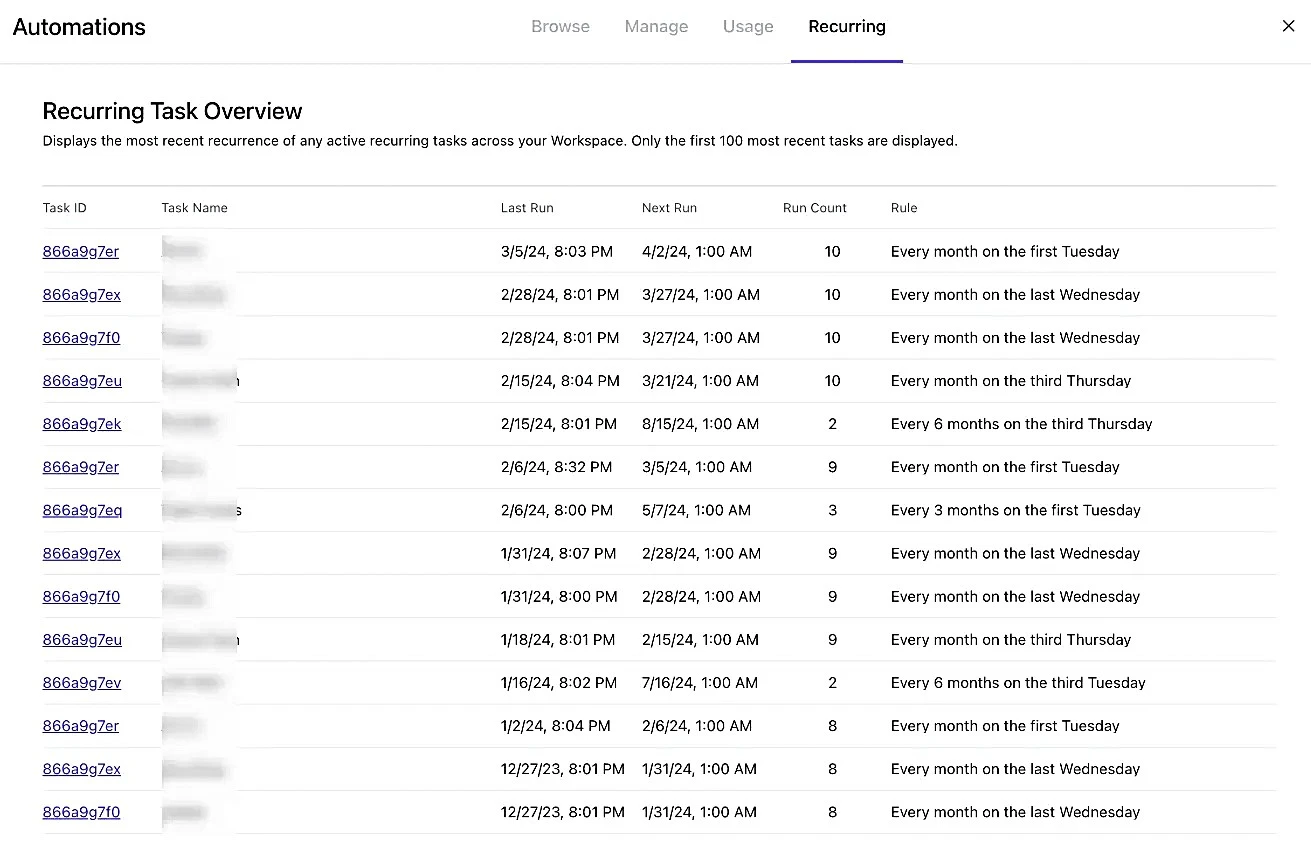
Introduction
When you're trying to make your business run better, there are lots of tools and tricks you can use. But there's one simple feature many people don't use enough: recurring tasks. In this article, we'll take a close look at ClickUp's recurring tasks feature. We'll show you how it can make your work easier and help your business run more smoothly.
Understanding ClickUp Recurring Tasks
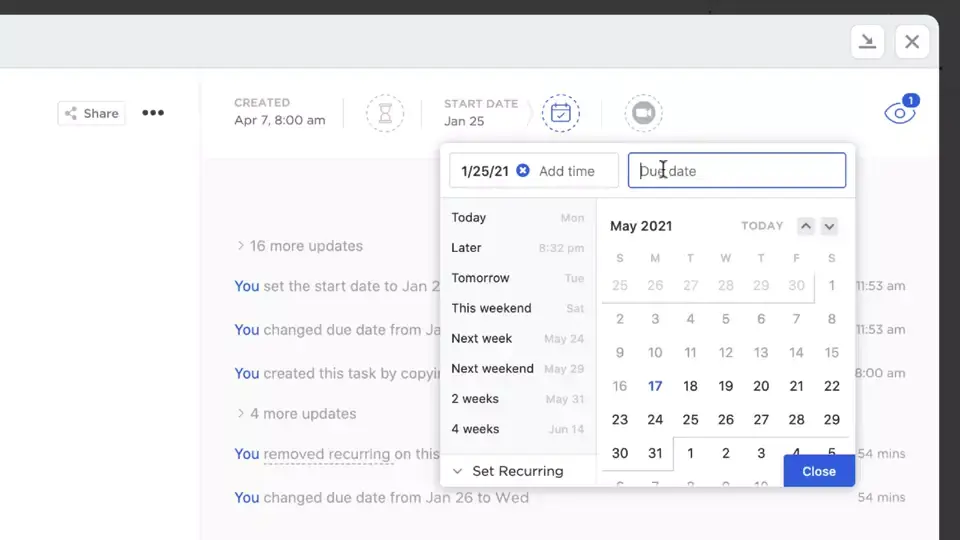
What Are Recurring Tasks?
Recurring tasks in ClickUp are tasks that repeat automatically based on a schedule you choose. It's like having a helpful assistant who creates a new task for you without you having to do anything. Whether it's a daily team meeting, a weekly review, or a yearly planning session, recurring tasks make sure these important activities always show up in your task list.
Why Are Recurring Tasks Helpful?
Recurring tasks can help you in several ways:
- They save time: You don't have to manually create a new task over and over. The recurring task does it for you.
- They keep things consistent: Each time a task will recur, it has the same information and setup. This helps keep your work processes the same every time.
- They prevent forgotten tasks: Because tasks show up automatically, you're less likely to forget important regular activities.
- They help you plan better: You can see future recurring tasks in calendar view, which helps you plan your time and resources better.

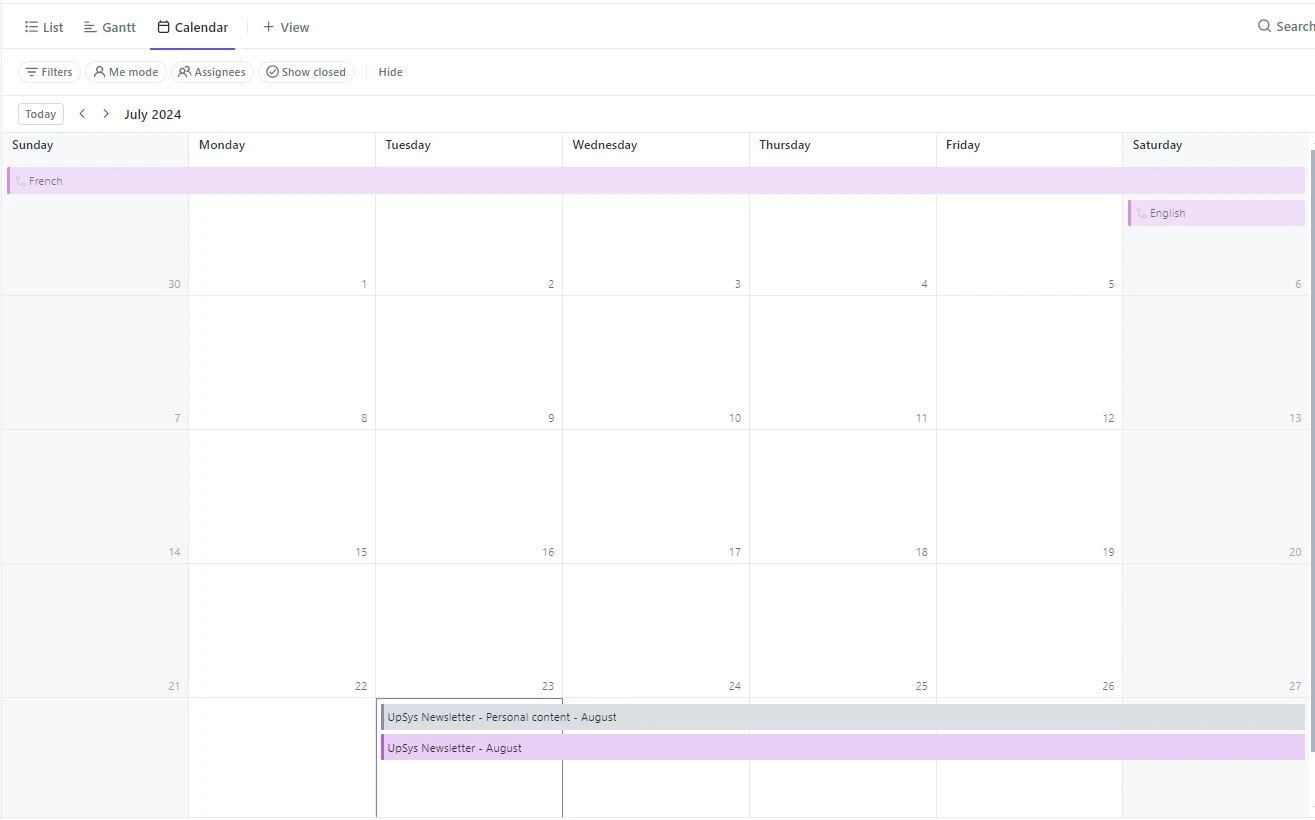
How to Set Up Recurring Tasks in ClickUp
Let's go through how to set up a recurring task in ClickUp, step by step:
- Start with a task: Open a task you want to make recurring, or create a new one.
- Set the due date: Click where it says "Due Date" to open the calendar.
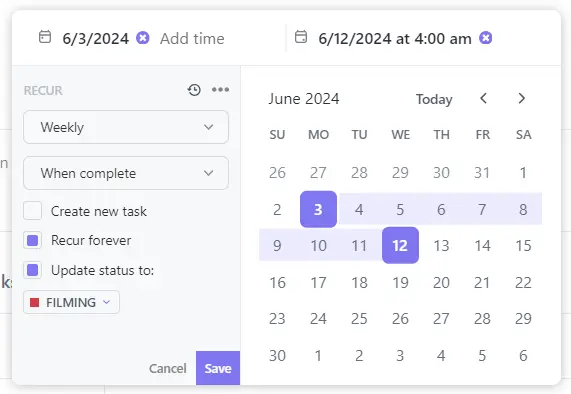
3. Make it recurring: Look for the "Set recurring" option when you're setting the due date.
4. Choose your recurring task settings: This is the important part. You need to decide:
- How often the task repeats (daily, weekly, monthly, yearly, or a custom schedule)
- When it starts and ends (if it does end)
- What makes a new task appear (when you finish the old one, or on a set schedule)
- What status the new task should have
- What information should carry over to the new task
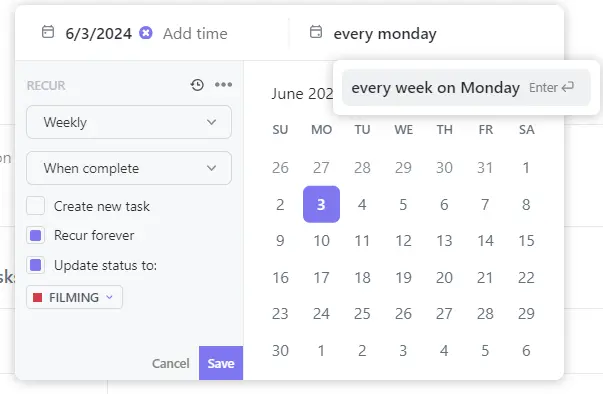
5. Set to recur: Make sure you select the appropriate options to set to recur based on your needs.
6. Save your choices: Once you've set everything up, save your recurring task.
Important Things To Think About When Setting Up Recurring Tasks
Pay close attention to these settings when you're creating a recurring task:
- How often it repeats: ClickUp lets you be very specific here. You can make tasks repeat every few days, weeks, or months. You can even set custom patterns like "every 21 days" or "every 3 months".
- What makes a new task appear: You can choose between "when complete" or "on schedule". "On schedule" is usually better because it creates new tasks even if you haven't finished the old one.
- What status new tasks should have: It's usually best to set this to "open" or "to do".
- What information carries over: This is really important. You usually want to turn off comments, attachments, and activity carrying over to keep each new task clean and focused.
When to Use Recurring Tasks (and When Not To)
Good Times To Use Recurring Tasks
Recurring tasks work best for work that happens on a regular schedule. Some good examples are:
- Team meetings that happen every week
- Monthly checks on your finances
- Setting goals every three months
- Yearly employee reviews
- Regular equipment checks
- Reports you have to do on a schedule
The key is to look for work that happens in a regular pattern.
When Not To Use Recurring Tasks
While recurring tasks are great, they're not right for every situation. Don't use them for:
- Work that comes up randomly: If tasks pop up without warning or on demand, recurring tasks aren't the right choice. Instead, try using templates that you can quickly copy when needed.
- Work that changes a lot each time: If the task is very different each time you do it, a recurring task might not work well.
- One-time projects: Don't set tasks as recurring if they don't actually repeat. This can clutter up your workspace with unnecessary future tasks.
Remember, the goal is to make your work easier, not more complicated. Use recurring tasks where they truly help make your work more efficient.
Real-World Examples: Setting Up Recurring Tasks
Let's walk through a practical example of setting up recurring tasks for a monthly newsletter.
Monthly Newsletter
Now, let's set up a recurring task for a monthly newsletter:
- Create a main task called "Publish Monthly Newsletter".
- Set the start date to the 1st of the month and the due date to the 28th of the month (or adjust based on your newsletter schedule).
- Add subtasks for the newsletter process, such as:
- "Brainstorm content ideas" (Due: 5th)
- "Draft articles" (Due: 15th)
- "Design newsletter layout" (Due: 20th)
- "Review and edit content" (Due: 25th)
- "Send test email" (Due: 27th)
- "Send newsletter to subscribers" (Due: 28th)
- In the task description, include your newsletter template or content guidelines.
- Set the task to recur monthly.
- Choose "on schedule" for the recurrence trigger.
- Set the status for new recurrences to "open".
- In the recurrence options:
- Turn off inheritance for comments and attachments (so each month starts fresh).
- Keep inheritance on for the task description (to maintain your template/guidelines).
- Consider keeping subtasks inheritance on if your process remains the same each month.
- Optionally, set up custom fields to track metrics like open rates or subscriber growth for each newsletter.
This setup creates a structured workflow for your monthly newsletter, ensuring all steps are completed on time and allowing you to easily track progress and performance over time.
Extra Tips for Using Recurring Tasks
Here are some additional tips that can help you use recurring tasks more effectively:
- Use "on schedule" for task creation: It's recommended to use the "on schedule" option for creating new recurring tasks. This ensures that even if you haven't completed the previous task, the next one will still be created. This helps you stay on track with your recurring work.
- Be careful with inheritance: It's important to turn off inheritance for comments, attachments, and activity. This keeps each new recurring task clean and focused on the work at hand, rather than cluttered with old information.
- Nested subtasks: If your recurring task has subtasks, make sure their due dates fall within the original task's start and due dates. This keeps everything organized and properly scheduled.
- Customizable frequency: Remember that you can set very specific recurrence patterns. Don't feel limited to just daily, weekly, or monthly. You can set tasks to recur every 21 days, every 6 weeks, or any other pattern that fits your needs.
- Use with other ClickUp features: For ad-hoc work, you might want to use templates triggered by automations instead of recurring tasks. This shows that recurring tasks can be part of a larger strategy using multiple ClickUp features.
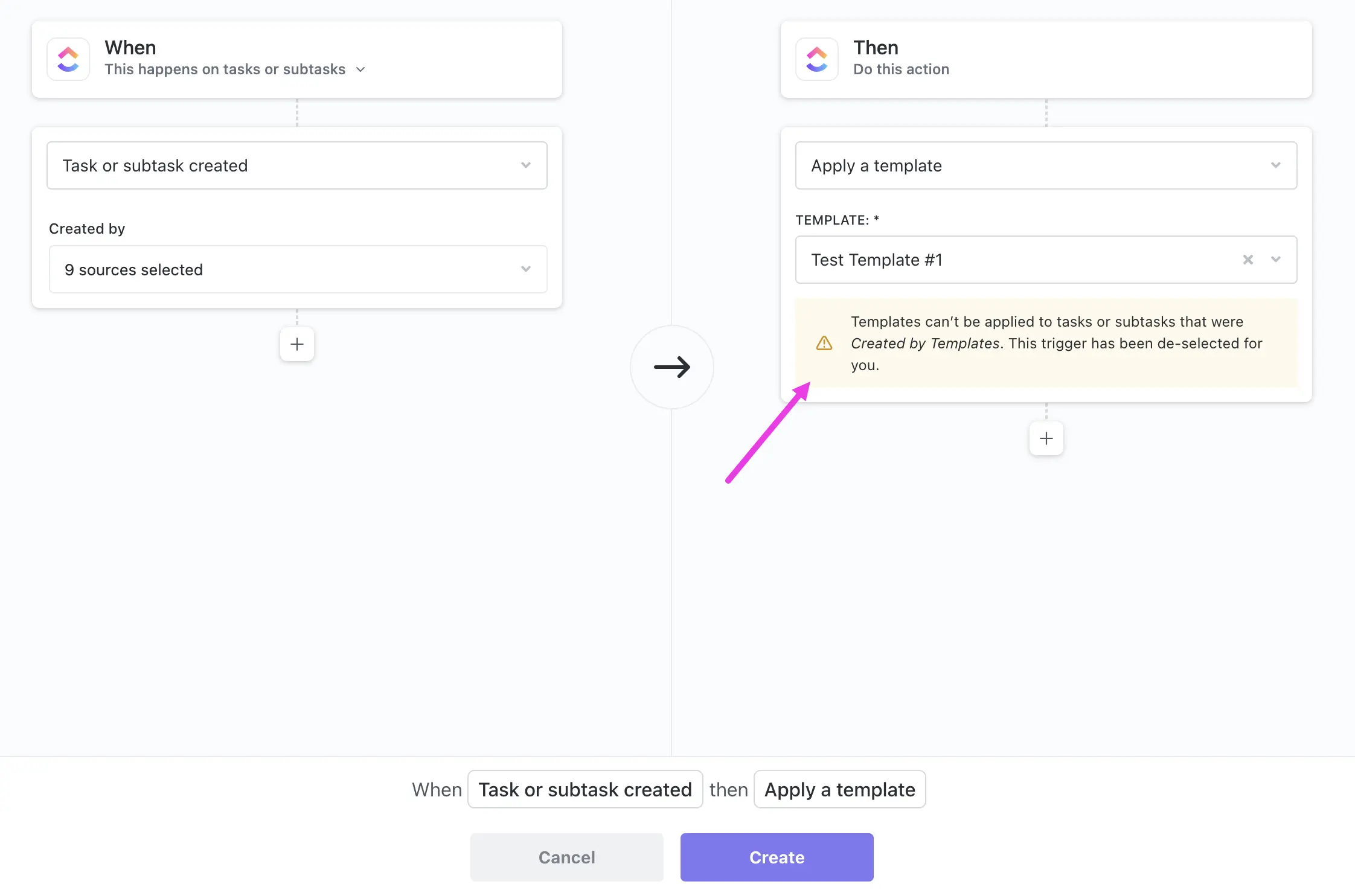
Conclusion and Next Steps
ClickUp's recurring tasks are a simple but powerful way to keep your business processes consistent and efficient. By automatically creating regular tasks for you, they free up your mind and make sure important activities are never forgotten.
To get the most out of recurring tasks:
- Look at your current work and see where you could use recurring tasks.
- Try setting up a few recurring tasks and see how they work for you.
- Regularly check your task recurring settings to make sure they're still helpful and set up correctly.
- Think about using recurring tasks along with other ClickUp features like templates and automations to make your work even more efficient.
By learning to use recurring tasks well, you're taking a big step toward having a more organized, consistent, and productive workflow. So why not start today? Explore ClickUp's recurring tasks feature and see how it can transform the way your business works!
Got a project with ClickUp?
Book a call Now 🗓️Supercharge your business today








